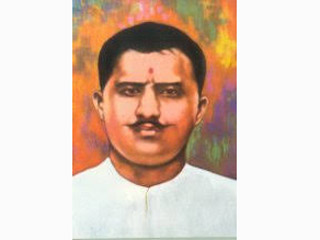Unsung Heroes : Ram Prasad Bismil
On the occasion of his Birth Anniversary on 11th June 2020
 Ram Prasad Bismil (11th June 1897 – 19th December 1927) was an Indian revolutionary who participated in Mainpuri conspiracy of 1918, and the Kakori conspiracy of 1925, and struggled against British imperialism. Besides being a freedom fighter, he was a patriotic poet and wrote in Hindi and Urdu using the pen names Ram, Agyat and Bismil. However, he became popular with the last name ‘Bismil’ only. He was associated with the Arya Samaj where he got inspiration from Satyarath Prakash, a book written by Swami Dayanand Saraswati. He also had a confidential connection with Lala Har Dayal through his Guru Swami Somdev, a preacher of Arya Samaj.
Ram Prasad Bismil (11th June 1897 – 19th December 1927) was an Indian revolutionary who participated in Mainpuri conspiracy of 1918, and the Kakori conspiracy of 1925, and struggled against British imperialism. Besides being a freedom fighter, he was a patriotic poet and wrote in Hindi and Urdu using the pen names Ram, Agyat and Bismil. However, he became popular with the last name ‘Bismil’ only. He was associated with the Arya Samaj where he got inspiration from Satyarath Prakash, a book written by Swami Dayanand Saraswati. He also had a confidential connection with Lala Har Dayal through his Guru Swami Somdev, a preacher of Arya Samaj.
Bismil was one of the founding members of the revolutionary organisation ‘Hindustan Republican Association’. Bhagat Singh praised him as a great poet-writer of Urdu and Hindi, who had also translated the books ‘Catherine’ from English and ‘Bolshevikon Ki kartoot’ from Bengali.
Early life
Ram Prasad Bismil was born on 11th June 1897 at Shahjahanpur, in North-Western Provinces in British India. He was sent to learn Urdu from a Moulavi. He was admitted to an English-language school, despite his father’s disapproval, and also joined the Arya Samaj. Bismil showed a talent for writing patriotic poetry.
Mainpuri conspiracy
Bismil formed a revolutionary organisation called ‘Matruvedi’ (Altar of Motherland) and contacted Genda Lal Dixit, a school teacher at Auria. Somdev arranged this, knowing that Bismil could be more effective in his mission if he had experienced people to support him. Dixit had contacts with some powerful dacoits of the State. Dixit wanted to utilise their power in the armed struggle against the British rulers. Like Bismil, Dixit had also formed an armed organisation of youth. The pair organised youth from the Etawah, Mainpuri, Agra and Shahjahanpur Districts (now in Uttar Pradesh) to strengthen their organisations.
On 28th January 1918, Bismil published a pamphlet titled – Deshvasiyon Ke Nam Sandesh (A message to the countrymen), which he distributed along with his poem ‘Mainpuri Ki Pratigya’ (Vow of Mainpuri). To collect funds for the party, looting was undertaken on 3 occasions in 1918. Police searched for them in and around Mainpuri while they were selling books proscribed by the UP Government in the Delhi Congress of 1918. When the Police found them, Bismil absconded with the unsold books. When he was planning another looting between Delhi and Agra, a Police team arrived and firing started from both the sides. Bismil jumped into the Yamuna River and swam underwater. The Police and his companions thought that he had died in the encounter. From there, he fled to Delhi and lived in hiding. A criminal case was filed against those who took part in the incident. Later, everybody was exonerated. The incident is known as the ‘Mainpuri Conspiracy’.
Formation of Hindustan Republican Association
From 1919 to 1920, Bismil remained inconsp-icuous, moving around various villages in United Province. In 1921, he returned to Shahjahanpur and mobilised the youth of United Province for non-cooperation with the Government. The people of UP were so influenced by the furious speeches and verses of Bismil that they became hostile against the British Raj. As per a statement of Banarsi Lal in the court – “Ram Prasad used to say that Independence would not be achieved through non-violence”.
In January 1923, a rich group of the party formed a new ‘Swaraj Party’ under the joint leadership of Moti Lal Nehru and Chittranjan Das, and the youth group formed a revolutionary party ‘Hindustan Republican Association’ under the leadership of Bismil.
Kakori conspiracy
Bismil executed a meticulous plan for looting the Government treasury being carried in a train at Kakori, near Lucknow in UP. This historical event happened on 9th August 1925 and is known as the ‘Kakori Conspiracy’. Ten revolutionaries stopped the 8 Down Saharanpur-Lucknow passenger train at Kakori – a station just before the Lucknow Railway Junction. German-made semi-automatic pistols were used in this action. Ashfaqulla Khan, the lieutenant of the HRA Chief Ram Prasad Bismil gave away his Mauser and engaged himself to break open the cash chest. Eagerly watching a new weapon in his hand, Manmath Nath Gupta fired the pistol and accidentally shot and killed a passenger Ahmed Ali, who had gotten down from the train to see his wife in the ladies compartment.
More than 40 revolutionaries were arrested whereas only 10 had taken part in the dacoity. Following 18 months of legal process, Bismil, Ashfaqulla Khan, Roshan Singh and Rajendra Nath Lahiri were sentenced to death. Bismil was hanged on 19th December 1927. Bismil’s body was taken to the Rapti River for a Hindu cremation, and the site became known as Rajghat.